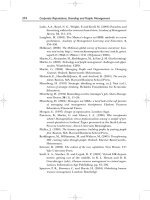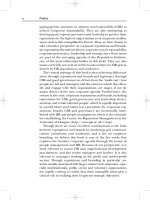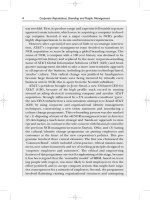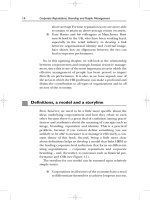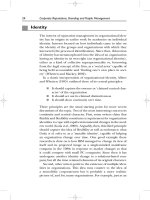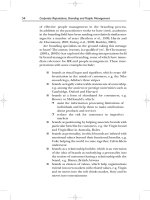Tài liệu MASTERING TRADE SELECTION AND MANAGEMENT : ADVANCEDSTRATEGIES FOR LONG-TERMPROFITABILITY docx
Bạn đang xem bản rút gọn của tài liệu. Xem và tải ngay bản đầy đủ của tài liệu tại đây (5.27 MB, 240 trang )
MASTERING TRADE
SELECTION AND
MANAGEMENT
New York Chicago San Francisco Lisbon
London Madrid Mexico City Milan New Delhi
San Juan Seoul Singapore Sydney Toronto
ADVANCED STRATEGIES FOR
LONG-TERM PROFITABILITY
JAY NORRIS
with AL GASKILL
Copyright © 2011 by The McGraw-Hill Companies, Inc. All rights reserved. Except as permitted
under the United States Copyright Act of 1976, no part of this publication may be reproduced or
distributed in any form or by any means, or stored in a database or retrieval system, without the
prior written permission of the publisher.
ISBN: 978-0-07-176011-9
MHID: 0-07-176011-3
The material in this eBook also appears in the print version of this title: ISBN: 978-0-07-175498-9,
MHID: 0-07-175498-9.
All trademarks are trademarks of their respective owners. Rather than put a trademark symbol
after every occurrence of a trademarked name, we use names in an editorial fashion only, and to
the benefi t of the trademark owner, with no intention of infringement of the trademark. Where
such designations appear in this book, they have been printed with initial caps.
McGraw-Hill eBooks are available at special quantity discounts to use as premiums and sales
promotions, or for use in corporate training programs. To contact a representative please e-mail
us at
This publication is designed to provide accurate and authoritative information in regard to the
subject matter covered. It is sold with the understanding that neither the author nor the publisher
is engaged in rendering legal, accounting, securities trading, or other professional services. If
legal advice or other expert assistance is required, the services of a competent professional
person should be sought.
—From a Declaration of Principles Jointly Adopted by a Committee of the
American Bar Association and a Committee of Publishers and Associations
TERMS OF USE
This is a copyrighted work and The McGraw-Hill Companies, Inc. (“McGrawHill”) and its
licensors reserve all rights in and to the work. Use of this work is subject to these terms.
Except as permitted under the Copyright Act of 1976 and the right to store and retrieve one copy
of the work, you may not decompile, disassemble, reverse engineer, reproduce, modify, create
derivative works based upon, transmit, distribute, disseminate, sell, publish or sublicense the
work or any part of it without McGraw-Hill’s prior consent. You may use the work for your own
noncommercial and personal use; any other use of the work is strictly prohibited. Your right to
use the work may be terminated if you fail to comply with these terms.
THE WORK IS PROVIDED “AS IS.” McGRAW-HILL AND ITS LICENSORS MAKE
NO GUARANTEES OR WARRANTIES AS TO THE ACCURACY, ADEQUACY OR
COMPLETENESS OF OR RESULTS TO BE OBTAINED FROM USING THE WORK,
INCLUDING ANY INFORMATION THAT CAN BE ACCESSED THROUGH THE
WORK VIA HYPERLINK OR OTHERWISE, AND EXPRESSLY DISCLAIM ANY
WARRANTY, EXPRESS OR IMPLIED, INCLUDING BUT NOT LIMITED TO IMPLIED
WARRANTIES OF MERCHANTABILITY OR FITNESS FOR A PARTICULAR PURPOSE.
McGraw-Hill and its licensors do not warrant or guarantee that the functions contained in the
work will meet your requirements or that its operation will be uninterrupted or error free. Neither
McGraw-Hill nor its licensors shall be liable to you or anyone else for any inaccuracy, error or omission,
regardless of cause, in the work or for any damages resulting therefrom. McGraw-Hill has
no responsibility for the content of any information accessed through the work. Under no
circumstances shall McGraw-Hill and/or its licensors be liable for any indirect, incidental, special,
punitive, consequential or similar damages that result from the use of or inability to use the
work, even if any of them has been advised of the possibility of such damages. This limitation of
liability shall apply to any claim or cause whatsoever whether such claim or cause arises in
contract, tort or otherwise.
• iii •
CONTENTS
Preface v
PART ONE: MARKET ANALYSIS 1
Chapter 1 Before You Trade 3
Chapter 2 Preparing to Trade 17
Chapter 3 Market Overview 31
Chapter 4 Identifying Strength and Weakness 67
Chapter 5 Fundamentals of Risk and Price Movement 85
Chapter 6 Market Framework 115
PART TWO: TRADING 125
Chapter 7 Trade Setup 127
Chapter 8 Trigger Defined and Trade Entered 143
Chapter 9 Trade Management 161
Chapter 10 Trade Examples with Trading Plans 191
Conclusion 211
Index 215
This page intentionally left blank
• v •
PREFACE
O
ur first book, Mastering the Currency Market (McGraw-Hill
2009), was written to provide a foundation for learning the art of
discretionary trading, and it should be a prerequisite for this book.
Mastering Trade Selection and Management focuses on helping you
to collate and balance the earlier information, and to refine the trad-
ing techniques that you are likely to use for the rest of your career.
Along with covering the all-important topics of trade selection and
management, this book also addresses the necessity of being able to
draw up a plan and stick to that plan. By helping you understand the
necessity of developing your “trader’s mindset,” reading this book will
help to protect you from your previous opinions and belief system.
The best way I know to teach someone to trade is to demonstrate
to him how to trade. That’s what I do three hours a day, three days a
week during the London/U.S market overlap. By conducting live,
interactive market exercises for my clients, pointing out trade setups
and triggers in the currency markets as they are occurring during such
a busy time of the day, and demonstrating how to manage these trades,
I lend clients the confidence and expertise to demonstrate to them-
selves that they can learn to trade. That is what this book and our
courses are all about: teaching you the steps and lessons it will take to
prove to yourself that you can succeed in the world’s most financially
rewarding arena.
There is no doubt among high-level traders that you must have a
subconscious belief that your trading method is going be profitable.
However, no matter how much positive attitude you bring to the table,
you have to have a trading method first. A trading method is a proce-
dure that you will follow to identify first a market to trade, then the
direction that the market is moving in, then a set of circumstances that
lead you to focus in on a particular price level at a particular time, and
finally a definite signal to initiate a position in that market. How and
when you use this method to enter, manage, and exit trades will be
spelled out explicitly in a document you create called a trading plan.
The method you employ and your trading plan will be what many
experienced traders call “your edge.”
The method you choose should be robust, meaning that it needs
to work in any economic environment, and it should be scalable,
meaning that it will work on time frames from the shorter-term intra-
day on up to the monthly and weekly time frames. It needs to work in
both bull and bear markets, and it needs to work in the multitude of
markets that are available to investors and traders today. The method
also needs to be completely independent of what you, or your friend,
or your friend’s broker thinks about the current or future direction of
the market in question.
The method you employ needs to be able to give you the current
trend for whichever slice of time you are looking at. And if by defini-
tion the method can define direction on any time frame, then it must
also be able to point out at what time and at what price the direction
changed. With this information, we can now measure a market’s direc-
tion at any given time, particularly around those times when signifi-
cant economic events are unfolding or have already taken place. This
book will teach you such a method and give you the framework to
measure a stock, commodity, or currency trend on a yearly, monthly,
or weekly basis, or on any other time frame, in the context of the
current economic environment.
Think about that for a moment. After studying the techniques
taught in this book, you will be able to quantify the effects that fun-
damental developments such as employment, government interest-
rate policy, or consumer confidence actually have on the markets you
follow. You will know ahead of time what levels would need to be
breached to signal a change in trend. At week’s end or month’s end,
vi • Preface
you can check the trends in the markets or investment vehicles you
follow and know whether the current trend is holding or has changed.
When the market is approaching historical support or resistance levels,
such as yearly highs or lows, or long-term retracement levels, you can
monitor it down to the daily or even intraday time frames to help you
make decisions such as to take a portion of your position off and move
your stops closer, to hedge your position with options, or to exit your
position and wait for more favorable circumstances. If a sudden
change occurs in the financial markets, you will have a reliable means
of gauging the effects of it on any market that is of interest to you.
Before any of this can happen, however, we need to demonstrate these
techniques to you so that you can go on and prove to yourself how
effective they are. Once you see that what we teach works, you can
decide for yourself whether you want to use our methods to trade.
Doing so will entail writing out a trading plan in detail, back-testing
that plan extensively, then demo trading that plan in live markets for
a time that is measured not in days or weeks, but in months or even
years. We know that many students will not succeed because they
aren’t willing to listen or write up a trading plan or patient enough to
manually back-test in an organized manner by recording trades for
honest evaluation. A large percentage of retail account holders fail
because they don’t know that they need to do all these things. How-
ever, many fail even after they know this because they won’t or can’t
risk the resources and time required to achieve the reward, or they just
aren’t suited to an endeavor in which the outcome of each individual
trade is unknown 100 percent of the time. A professional already has
the will to succeed before she chooses the specific goal or method. It
is unlikely that anyone can teach you to have that desire.
What we give you in this book is detailed step-by-step instructions
on how to select a market to trade, how to determine which direction
to trade that market from, what to look for prior to trading, and when
to initiate a trade. We also help prepare you for the emotional
Preface • vii
challenges you will face in trading, such as letting a profit run and not
exiting a trade too early, or being fearful of taking a trade signal and
losing money, or, more to the point, fear of being wrong. We will teach
you how to know whether you are trading with the long-term trend or
counter to it, and show you how to differentiate between a trending
and a countertrending market. We will also teach you what to expect
when managing a trade, and prepare you for the different market
scenarios that can occur while you are in a trade. You need to know
exactly what to do when a trade is going your way; what to do when
it’s pausing, which happens often; and what to do when it seems like
it’s failing.
Before you move forward on your own journey, though, it’s impor-
tant that you absorb this book. Then move forward at a relaxed, sure
pace, and use the tools and tactics we’ll be teaching you as they were
meant to be used. You should be in no hurry; rather, you should be com-
fortable in knowing that this is your journey and you can move forward
at a pace that suits you. And most important, realize that the only
person who can get in the way of your success is you. There is no doubt
about it: trading is well over 90 percent mental, which is why we must
address your own thought process and belief system before we get
into methodology.
viii • Preface
PART ONE
Market Analysis
This page intentionally left blank
Chapter 1
BEFORE YOU TRADE
M
ost new traders realize after only a few live trades that they are
terrified of the markets, and this fear is a major reason why so
many traders fail.
Fear and Trading
Most people aren’t able to execute under the pressure that their fear
creates. I’ve had plenty of clients admit that putting on a live trade,
particularly after a losing trade—or worse, a string of losers—is one of
the hardest things they’ve ever had to do. Is it the money that causes
them so much fear? To a degree yes, particularly if they are under-
capitalized to begin with, but plenty of traders tell of being just as
fearful while trading micro contracts, or even when executing trades in
a demo account. So it’s not just the money that brings out such strong
emotions. What about fear of failure? We’re probably getting warmer.
Failing at a vocation is a fearful thought. However, we feel that it is
actually thoughts about your future that cause so much emotion.
The idea of a future life in which your computer has become your
personal cash station, which is essentially what will happen if you
master the art of discretionary trading, is truly the equivalent of heaven
on earth for most of us. Can you imagine not having to worry about
money? Imagine being in a position to help out your family, your
friends, or any charity that you thought worthy. That would certainly
• 3 •
be a good position to be in! Your life would be like one of those car
commercials around the holidays where your loved ones look out the
window and there is a brand-new luxury SUV parked at the perfect
angle in your marble-lined driveway with a big red bow on top.
That’s what you want. That’s what you’ve been dreaming about
since fourth grade, when you first found out that your parents had to
work all day to get paid money to buy you shoes, put gas in the car,
and save money for your tuition. And now you’ve found a way to get
beyond all the work and worry. Now you can pay for your family to
come along on your Hawaiian vacation in January. Whether you know
it or not, this is how your subconscious thoughts work. Moments after
you find out how trading works and how you have control over every
decision and can make unlimited amounts of money, you start dream-
ing the near-impossible dream. But it’s no longer impossible to you.
There are people who do it—granted not many, but you realize that
it is possible.
From that moment on, you start mentally blocking out anything
that could possibly get in the way of your achieving that dream of total
freedom. And that’s when, rather than coming up with a sound plan
to achieve such a lofty goal, you start taking wrong turns. Rather than
addressing the roadblocks along the way—inexperienced mindset,
improper method, no back-testing information, no trading plan, over-
paying for educational services and transaction costs, and so on—you
pretend that they are not there, because too often the people you go
to for help in achieving this fantastic dream of total freedom are the
same people who make a living from cashing checks written by you
and people like you. It’s human nature to agree with someone who is
telling you what you want to hear, and it’s not an easy thing for the
average person to back up and change course once he’s made even a
modest investment of either time or money.
Usually it’s right about the time that you actually start trading live that
you start to realize that you are a long way from that dream of the holiday
4 • PART ONE: Market Analysis
Lexus in the driveway and the Hawaiian vacation, and, worse yet, you
are out a bit of time and money. That cash station that you thought your
computer was to become is more like a Pandora’s box, with e-mails
coming from this training service and that signal service about every
12 minutes. You realize that the trading course you bought didn’t come
with a phone number that you could call when you have questions, and
your e-mail questions keep coming back with another sales pitch to
upgrade to the next-level course for only $5,995.00. Are you scared?
Terrified is more like it because instead of making incremental headway
toward a lofty goal, you’re starting to realize that you’re in a position
where common sense (and your spouse) is telling you to stop throwing
good money after bad and accept your place in life, which is where you
were before you cooked up this dream of being a trader. You now have
three choices: stay scared, be depressed, or keep going down the dark,
narrow tunnel you find yourself in.
Do you still want to be a trader?
If the answer is still yes, you’d better get on the right path, which
means a lot of manual back-testing and then demo trading with
different methods until you settle on the right method and finalize
your trading plan. And while this is a good road to be on, you’re still
going to face mental hurdles that may be based on conditions you
probably are not aware of.
Your Belief System and the Markets
“No talking politics at the dinner table” is something that many of us
heard often while we were growing up. It was sound advice because it’s
healthier to ingest a meal in a calm, relaxed state than it is to do so while
trying to fortify a political opinion or defend against someone else’s. A
similar statement would be appropriate for trading: “No thinking about
politics when investing or trading.” This is sage advice because what you
happen to believe can cost you a lot of money in the marketplace. Many
Chapter 1: Before You Trade • 5
of you are going to have to learn to ignore your opinions if you are going
to make money as a trader. While this may sound simple, it is not.
Whether you realize it or not, you have an internal belief system that
started developing when you were just a toddler and has been reinforced
at every major event in your life.
It sounds so simple to say, “Lose your opinion, not your money,”
but it is not easy to do. Just ask any investor or trader who failed to act
on buy signals in the U.S. stock market in the late winter of 2009
because from a political or economic standpoint, she didn’t have
confidence in the then-new U.S. president’s administration and
policies. Imagine being a professional money manager and having
to explain to investors that your “opinion” kept you on the sidelines
while the S&P 500 ripped off a 50 percent rally from the March 2009
low through year-end. Or worse, you tried to trade counter to the
monthly trend and went short stocks or the carry trade in mid-2009,
and you didn’t heed the “buy” signals quickly enough when the
market turned higher in mid-July of that year. Either way, if you were
a professional, you would probably be out of a job.
What historical price behavior has always highlighted is the impor-
tance of using trading methods that remove the liability of your opinion.
You need to understand that it would be extremely difficult, if not
impossible, to keep track of every current or future event or organization
that can affect a market. This is why you need an edge, or a method, that
you can count on to identify the market’s direction following influential
events, or at the end of the day, week, or month. The trading techniques
we cover in this book will provide that, and they are straightforward and
simple to grasp. But we know that many traders will complicate them
unnecessarily by judging them in the context of their own belief system
regarding the current economy or political environment.
Another way of saying this is to say that certain readers will be look-
ing for the tools of technical analysis to confirm their own fundamental
outlook, or vice versa. Most of the time this will not work, because your
6 • PART ONE: Market Analysis
own outlook—that is, your opinion—will generally shade your analysis,
causing you to overlook what the chart is telling you. Nor does that
approach dovetail well with Baron Rothschild’s classic market advice:
“Buy when there’s blood in the streets,” which proved apropos in 2009
and means that when you absolutely feel like the market is going to zero
and you can’t imagine that it can ever recover, do the hardest thing imag-
inable and take the next buy signal, even when your mind is screaming
“Sell!” We prefer to leave it at: trade when structure—that is, support and
resistance—complements price pattern. The buy signal in Exhibit 1-1
following the 2009 low in the Dow Jones Industrial Average validates
this statement.
The monthly chart in Exhibit 1-1 is as black and white as it gets. The
only information on the chart, other than the dates, is derived from price.
The monthly open, high, low, and closing prices are the only input we
have, yet look at how effectively this information can be used. The 2002
Chapter 1: Before You Trade • 7
Exhibit 1-1
Source: www.esignal.com.
low is marked as potential support, and a trendline is drawn connecting
the monthly highs in the second half of 2008 during an accelerated down
move. Once price closes above structure—both the 2002 low and that
trendline—it indicates a potential change in the price pattern, and a buy
signal is given. Despite everything that was going on in the global economy,
debt markets, and various governments around the world, all you really
would have had to do was buy based on the knowledge that previous
trendline penetrations of similar duration had, more often than not, led
to sizable price moves.
This would have by no means ensured that price would move
higher, because the only guarantee in trading is that the outcome of
every trade is uncertain. That truism should not be discouraging,
though, because the current direction of a market is definitely meas-
urable on any time frame. While we may not know what the future
holds, we do know what direction a market is moving in right now.
But before we can show you that, we have to make sure that you’re
prepared to recognize that whatever you see will be through the lenses
of your existing belief system.
We worked with a trader in 2005, and despite his having a sound
understanding that oil inventories were decreasing while demand was
increasing, he just couldn’t bring himself to get long. Every time we
showed him a buy trigger following a correction, he had a reason not
to take the trade. One afternoon we were discussing the situation with
the nation’s strategic oil reserve, and out of the blue he started curs-
ing the U.S. president for not releasing the reserves to try to keep
down prices. “It’s the right thing to do,” he kept saying. I reminded
him that even if that were to happen, it might have only a very short-
term effect because of the substantial demand for oil from the U.S.
military alone at that time, not to mention the Chinese demand. This
really set him off, and as he cursed on, it suddenly hit us why he
couldn’t bring himself to get long oil in one of the biggest commodity
bull markets of our lives.
8 • PART ONE: Market Analysis
His belief system was opposed to what was happening in the current
economic environment for this commodity. Even though he had been
in the energy business for many years and understood that reserves
were questionable while demand was not, he was politically opposed
to the prolonged war in Iraq. The fact that the U.S. president at
the time was a former oilman himself only exacerbated his anger.
He couldn’t separate his goals as a trader from his subconscious
perception (belief) that by profiting from rising oil prices, he would
somehow be “a part of the problem.” The moral of that story is that
from a trader’s perspective, “ours not to reason why.”
Another example of traders getting attached to their beliefs, along
with a particular market outcome, and not seeing the writing on the
wall, this time on a larger scale, is what happened to so many of the
“bond-market vigilantes” of the 1990s. In Chicago and New York, many
proprietary trading shops that specialized in training young traders to
take advantage of price movement in the U.S. Treasuries and related
markets sprang up around the exchanges. Because of economic uncer-
tainty and fear of inflation, the Treasury bond and note markets were
susceptible to sell-offs that created interest-rate spikes, which were often
heightened by the trading activity of these “prop” traders, who became
known as “bond-market vigilantes”. They called themselves this because
they saw themselves as helping to establish the “true” interest rates,
despite what Washington politicians said interest rates should be.
These bond-market sell-offs created volatility, which was good for the
prop traders who worked on the “screen” and, like all traders, relied on
market movement. It was also a boon for the futures and options traders
on the floors. No one in the Treasury trading industry was complaining
about the higher interest rates this collective trading activity was caus-
ing, although they created problems for the rest of the economy. How-
ever, Robert Rubin, the incoming Treasury secretary and an astute Wall
Street trader himself, did notice and specifically targeted higher interest
rates and the bond-market vigilantes. It did not take long for Rubin’s and
Chapter 1: Before You Trade • 9
Fed Chairman Alan Greenspan’s lower-interest-rate policies to decimate
the bond-market vigilantes who wouldn’t or couldn’t reverse their short
positions. They became so attached to their identity as vigilantes that
they overlooked the timeless Wall Street adage, “Don’t fight the Fed.”
We remember hearing about a former bond trader who had worked for
a prop shop and who had had mid-six-figure years in the past having to
tell his wife that she had to go out and get a job if they were ever to have
a chance of putting their kids through college.
Why couldn’t the former vigilantes see that the tide had turned and
that they needed to work the long side of Treasuries, or understand that
lower rates might mean a weaker currency and turn to trading foreign
currencies? We’re not sure why, but we do know the dangers of being
pigeonholed by an opinion that becomes your identity.
If other professionals can be unduly influenced by their opinions
and perceived outlooks, don’t believe that it can’t happen to you. This
is why it’s important that you understand yourself first, before you start
to understand how markets move. And it’s even more important that
you understand that your previous experiences and thoughts are going
to have an outsized influence on your decision-making process if
you let them. The worst thing you can do as a trader is express your
opinion about the potential direction of a market that you plan on
trading. This is because you literally might believe yourself, and in
doing so implant an opinion in your mind that will hamper your
ability to spot the subtle changes that occur before a price correction
or reversal. Once you’ve gone on record with an opinion, you cloud
your own objectivity, whether you realize it or not.
“Love is blind” is an old saying that makes a lot of sense and is appli-
cable to trading as well because we all love being right, and getting
paid for it makes it an even more dangerous aphrodisiac. Stick to fact-
based assessments, such as the pattern of highs and lows in a market
and the current price direction on the monthly and weekly charts, and
do not fall into the trap of trying to predict a market’s outcome or,
10 • PART ONE: Market Analysis
worse, trying to call a “top” or “bottom” in the market. You must know
that as a trader, it is never your job to predict where a market is going
to go. Leave that to the analysts and financial bloggers who get paid
ad dollars by the word. Your job is going to be first to secure a method
that suits your lifestyle, back-test that method until you know how well
it works and why it works, then finalize a trading plan to cover every
contingency you can think of. After that, just stick to that plan and
take the trade signals it generates, regardless of what you think the
market is going to do. Then measure your progress one month at a
time, not one day at a time. And stay with a demo account until your
fear settles down to mild anxiety.
Why Do You Want to Trade?
The only answer to the question of why you want to trade should be to
earn a satisfactory rate of return on your money while protecting your
account principal. Another way of saying this is that you want to make
money to have a better life. If you are trading for ego, or bragging rights,
or greed, you will fail. There is an old joke in the futures industry that
asks: “How do you make a small fortune trading commodities?” The
answer: “Start with a big one.” There are plenty of stories in the big
trading families in New York and Chicago of children or grandchildren
of great traders who let their egos get in the way and tried to make more
than just money by making a name for themselves, which when com-
bined with excessive risk ended sadly, or even tragically. There are also
plenty of cases of successful businesspeople from other industries who
tried their hand at trading and ended up acting like a gambling addict
let loose in a casino.
It’s of paramount importance that you understand that trading is a
dangerous activity that can wipe out your account and leave you in
debt. This is why long before you risk even 10 cents in a micro
account, you had better understand that your only job as a trader is to
Chapter 1: Before You Trade • 11
execute your trading plan error-free with the goal of obtaining a steady
rate of return on your account balance. Ideally, you should plan on
being rewarded by steady returns over time. As your equity curve
improves, you can add more contracts accordingly. The more con-
tracts you trade, the greater your risk/reward scenario. Over the course
of months, then years, you can amass quite a sizable account just by
making modest gains week in, week out and month in, month out.
This is the only reason you should want to trade.
Buyer Beware
The saying “You get what you pay for” is gospel to generations of
people—particularly in America. But is it really so in the financial
industry? What if we told you that it’s a common belief among
brokers, particularly in the more speculative futures and forex
segments of the market, that the individual with the biggest, fanciest
office is the best “storyteller” in that company. And the broker in that
corner office is not there because he gives you a fair deal on your
transaction charges/commissions. The brokers who charge you the
most are generally so adept at mesmerizing their audience that
clients sign up without even questioning why they are paying such
exorbitant commissions.
When the average customer sees the broker’s office, she gets the
immediate impression that the broker must be taking good care of his
customers. Why else would he be in such a nice office? It all comes
back to our dream of the future. The office fits the dream. It makes
perfect sense that as an up-and-coming trader, we would have a broker
with such an office. He’s our new friend, and he’s there to help us. And
he’s worth every penny we pay in transaction costs because, as every-
one knows, you get what you pay for! It might be hard for you to believe
that a person would build his business on the strategy of seeking out
prospective clients and telling them whatever they wanted to hear in
order to hit his next month’s commission quota. Or is it? When you
12 • PART ONE: Market Analysis
are paying for services, particularly ones with such a high failure rate
as retail trading, you can expect that the businesspeople behind them
are going to get their fees up front. A very similar dynamic plays out in
the trading education field. Fortunately, there are simple ways to find
out if an educator is reputable.
First and foremost, can you get hold of the educator easily? If she
doesn’t have a contact phone number on her Web site or marketing
material, that should raise some red flags. Another important distinc-
tion to make is whether she has some form of live trading room. Any
time an educator is willing to put herself in front of you and a live
market, and point out how and when a method generates trades and
how to manage those trades, you can probably have some assurance
that she knows what she is doing.
Just as important, educators today should also be subject to some
form of regulatory review of their products and services. If you are con-
sidering purchasing educational products, there is nothing wrong with
calling the educator directly and asking him if he is registered in any
capacity and/or subject to regulatory review, and what form does this
supervision take? From the educator’s standpoint, any delay in getting
products and marketing material approved by the appropriate regulatory
agencies is going to be well worth the time. And educational products,
like products in any service industry, should be priced for a long-term
reciprocal relationship with the customer—you. If you believe that you
get what you pay for in the financial trading and education industries,
you need to rethink things.
Trading Corn in the Wheat Pit
Relationships change; behavior does not. The same is true of people
and markets. This is something that many of us learn when we finish
school or move out of our parents’ home and start to live in the real
world. We socialize in groups made up of friends from the old neigh-
borhood, friends from school, and new work associates. Our friends
Chapter 1: Before You Trade • 13
pair up and couple off, and two people who seemed perfect for each
other during the summer break up and end up avoiding each other
over the holidays. A job that seems to be perfect for a particularly ambi-
tious individual for the first few years may prove restrictive and not
challenging enough after four or five years. Another friend may accept
a better offer from a new firm that looks to be a great opportunity and
be envied by the group, only to return to her old job for less money
because she’s happier there. The only constant seems to be change.
What you need to know as a trader is that markets are the same. Just
as an individual is more predictable than a couple, and much more
predictable than a group of people, an individual market is easier to
analyze than a relationship between two markets or a group of markets.
There is no doubt that at times there are powerful correlations between
markets, yet just as you would not go to a group of people if you needed
information from one individual, you should not analyze seemingly
related markets if you are trading just one. Many new traders make the
mistake of taking a trade in one market based on the behavior of
another. This is a mistake, and one that we refer to as “trading corn in
the wheat pit.” It’s very important that you know that trading should
involve entering a trade in a market only if that particular market gave
you a specific signal to do so. You don’t want to fall into the habit of
buying corn just because the price of wheat is going up. Yes, they are
both grains, but there is nothing to stop one market from correcting
lower while the other goes sideways, or vice versa.
The same holds with related stocks and currency markets. Experi-
enced traders know that it is not the exception, but more to be expected
that in markets that share primary trends, one will often zig while the
other zags. This temporary divergence can prove costly to individuals
who don’t know better. And then there are those times when relationships
break down completely and markets that had previously had strong
correlations move in opposite directions. You will avoid the pitfalls of
putting too much weight on parallel analysis of related markets by
14 • PART ONE: Market Analysis
learning to enter trades or positions only because of specific price
behavior, known as a setup and trade trigger, in an individual market.
Different Trade Types
There are three different trade types we will be covering, and their
designation will depend on how long we plan on staying in the trade.
The first is a position trade, also called a trend trade, which we plan
on holding ideally for as long as several months, to a year, or at least
until the market starts to reverse against our position. We generally
identify a position trade as one where the direction on the daily chart
is aligned with the direction on the weekly and/or monthly chart. Our
goal in being in a position trade is to move along with a markets
primary trend, which we can identify as the price movement created by
the current business cycle. Because we are in the market for a longer
period of time, position trades have the highest risk/reward ratio.
The second is a swing trade, which we can take on any time frame
chart without regard for higher time frame trends. By taking swing
trades we are attempting to take advantage of the smaller trends at play
in a market, sometimes called secondary price swings. The advantage
of taking every swing trade signal on the chart is that you will by
default end up in the biggest price moves over that time period. While
swing traders may not enjoy the most impressive winning percentage,
their risk/reward ratio is generally favorable.
The third type of trade is a day trade, which is a trade that would
be closed out before the end of that day’s trading session. As a day
trader you have the choice of trading in the same direction as the
higher time frame trends or swing trading. Many traders are
attracted to this type of trading because of the perceived lower risk
associated with trading intraday charts. As you will learn in this
book, it is more important that you learn to trade from the higher
time frame charts first.
Chapter 1: Before You Trade • 15
This page intentionally left blank
